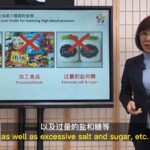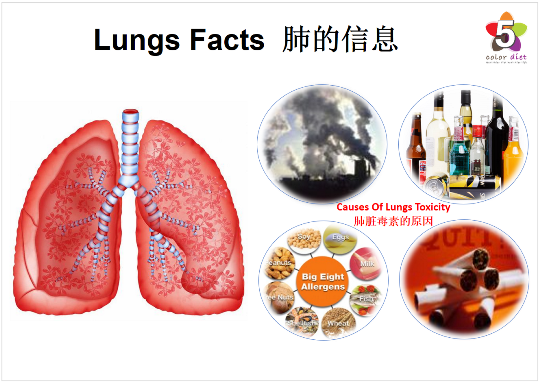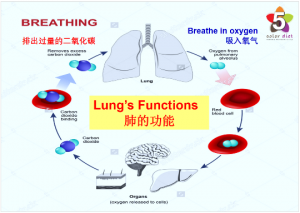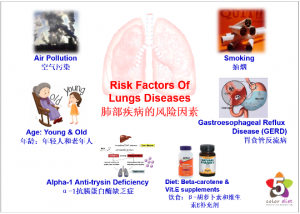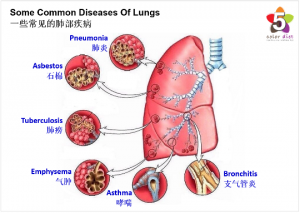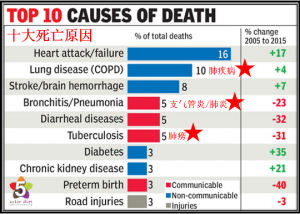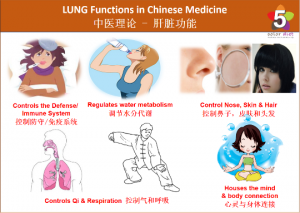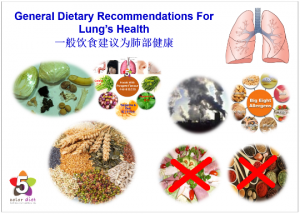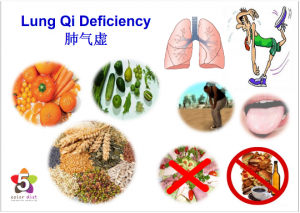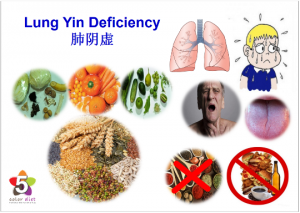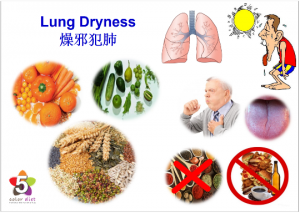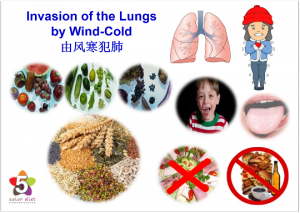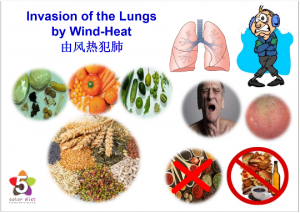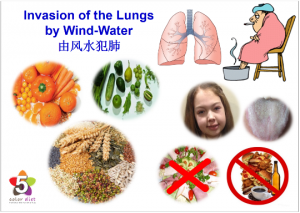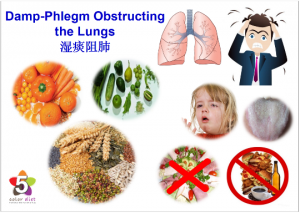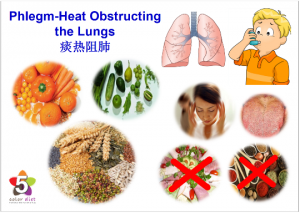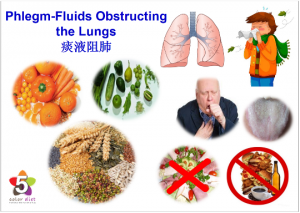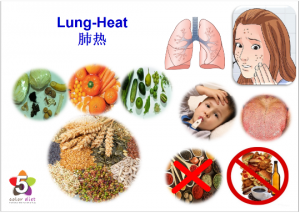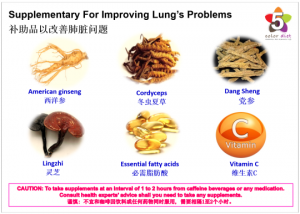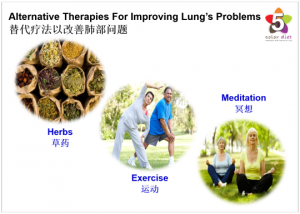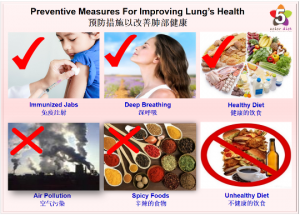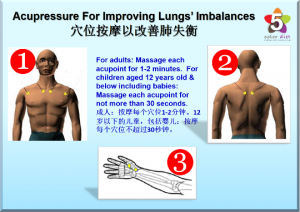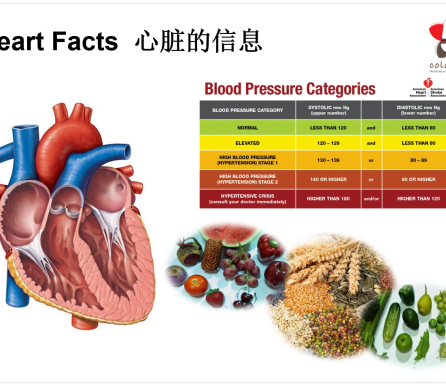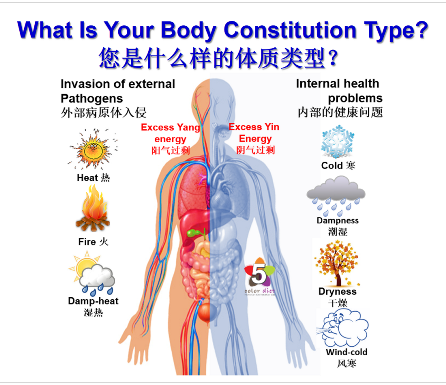
Lungs Overview
Lungs is the 1st detox organ which is also known as the first line of defense of our body against airborne bacterial & viral infections as well as environmental toxins, etc. The lungs’ main function is to help oxygen from the air we breathe, enter into our red blood cells. Red blood cells then carry oxygen around the body to be used in the cells found in our organs and tissues. The lungs also help the body to get rid of Carbon Dioxide gas when we breathe out.
Other functions by the lungs include changing the pH of blood (whether the blood is more acid or alkali) by increasing or decreasing the amount of Carbon Dioxide in the body; filtering out small blood clots formed in vein; filtering out small gas bubbles that may occur in the bloodstream & converting a chemical in the blood called angiotensin I to angiotensin II. These chemicals are important in the control of blood pressure.
Risk Factors Of Lung’s Diseases
There are several risk factors which increase your chance of getting a lung disease. Having a certain risk factor does not mean that you will develop the disease or that it is the direct cause of the disease. It just means that it is associated with it in some way and having a risk factor makes the chances of your getting the disease is higher. Some of the risk factors are modifiable (that is can be changed such as smoking and exposure to certain chemicals) whereas others cannot be modified such as family history, and age. If you don’t have a certain risk factor, it does not mean that you will not develop the disease.
● Air pollution: Air pollution may cause lung diseases such as asthma, bronchitis, and also lung cancer. According to studies, people exposed to large amounts of diesel exhaust fumes at work, are at higher risk of lung cancer (the risk increases by up to 47%). Similarly exposure to high levels of nitrogen oxides (mainly from cars and other vehicles) increases the risk of lung cancer by about a third. People constantly exposed to irritants in the workplace such as chemicals, dusts, gases, moulds and pollens are at higher risk of developing asthma. This is especially true for people who are in professions such as baking, painting of cars, Wood work and chemical production.
● Age: Age is a risk factor for certain lung diseases such as pneumonia, and other lung infections. Infections of the lung are more common in the elderly and very young.
● Alpha-1 Anti-trysin Deficiency: A small number of people have a rare form of Chronic Obstructive Pulmonary Disease (COPD) called Alpha-1 Anti-trysin deficiency-related emphysema. This form of Chronic Obstructive Pulmonary Disease (COPD) is caused by a genetic (inherited) condition that affects the body’s ability to produce a protein (Alpha-1) that protects the lungs.
● Diet: Studies showed that taking Beta-Carotene supplements increases the risk of lung cancer, especially in smokers who smoke one or more packs a day. The risk is higher in smokers who have at least one alcoholic drink every day. Also, studies of non-smokers show that taking Beta-Carotene & Vitamin E supplements do not lower their risk of lung cancer. In addition, Arsenic in drinking water (primarily from private wells) can increase the risk of lung cancer.
● Exposure to certain chemicals: Exposure to number of substances (asbestos, chemicals and gases) increases your risk of developing lung diseases such as asthma and lung cancer. Exposure to certain substances such as asbestos, metal dust and fumes, and polycyclic aromatic hydrocarbons in large amounts, when you work with them, increases your risk of lung cancer.
● Family history: If you have a family history of lung cancer or asthma, your risk of developing the condition is increased. It does not mean that you will definitely develop the condition. However, the exact genes or the extent to which genetic or hereditary factors contribute to lung diseases is not known.
● HIV infection: Being infected with the human immunodeficiency virus (HIV), the cause of acquired immunodeficiency syndrome (AIDS), is linked with a higher risk of lung cancer. People infected with HIV may have more than twice the risk of lung cancer than those who are not infected. Since smoking rates are higher in those infected with HIV than in those not infected, it is not clear whether the increased risk of lung cancer is from HIV infection or from being exposed to cigarette smoke.
● Radiation Therapy to the Chest: Cancer survivors who had radiation therapy to the chest are at higher risk of lung cancer.
● Radon: Radon is a naturally occurring gas that comes from rocks and dirt and can get trapped in houses and buildings. It cannot be seen, tasted, or smelled. According to the U.S. Environmental Protection Agency (EPA), radon causes about 20,000 cases of lung cancer each year, making it the second leading cause of lung cancer. Nearly one out of every 15 homes in the United States is thought to have high radon levels. The EPA recommends testing homes for radon and using proven ways to lower high radon levels.
● Smoking: The risk of several types of lung diseases such as bronchitis, lung cancer, and emphysema is increased in people who smoke. Smoking is the leading cause of lung cancer (smoking causes 9 out of 10 cases). Your risk of developing lung diseases is increased with the duration of smoking; the more you smoke, the more likely you are to get lung diseases especially lung cancer.
● Secondhand Smoke: Secondhand Smoke and the harmful chemicals in it are known causes of sudden infant death syndrome, respiratory infections, ear infections, and asthma attacks in infants and children. They are also known causes of heart disease, stroke, and lung cancer in adult nonsmokers. Smoke from other people’s cigarettes, pipes, or cigars (secondhand smoke) also causes lung cancer. When a person breathes in secondhand smoke, it is like he or she is smoking. In the United States, two out of five adults who don’t smoke and half of children are exposed to secondhand smoke, and about 7,300 people who never smoked die from lung cancer due to secondhand smoke every year.
Awareness about the risk factors can help you to avoid factors which can increase the chances of developing lung diseases as most factors for lung diseases are modifiable. If you have a family history of lung disease you should avoid smoking and occupational exposure to chemicals (factors which further increase the risk).
Some Common Diseases Of Lungs
● Asthma.
● Bronchiectasis, Bronchiolitis, Bronchitis.
● Bornholm disease.
● Cancer of the lung.
● Chronic obstructive pulmonary disease.
● Colds, coughs.
● Cystic fibrosis.
● Epiglottitis.
● Hiccups (hiccoughs).
● Idiopathic pulmonary fibrosis.
● Laryngitis.
● Legionnaires’ disease.
● Pleural effusion.
● Pneumonia.
● Pneumothorax.
● Pulmonary embolism.
● Sarcoidosis.
● Sleep apnea.
● Sinusitis.
● Some infections of the respiratory tract.
● Sore throat.
● Tonsillitis.
● Tuberculosis.
● Upper respiratory tract infections.
● Whooping cough, etc.
World Health Organisation (WHO) statistics on lung’s health problems in 2015 showed that:
● It is estimated that globally about 3 million deaths are caused by Chronic respiratory diseases (CRDs) which are diseases of the airways & other structures of the lung.
● More than 90% of Chronic obstructive pulmonary diseases (COPD) deaths occur in low & middle income countries.
● The primary cause of Chronic obstructive pulmonary diseases (COPD) is exposure to tobacco smoke (either active smoking or secondhand smoke).
● Other risk factors include exposure to indoor or outdoor air pollution and occupational dusts & fumes.
● Some cases of Chronic obstructive pulmonary diseases (COPD) are due to long-term asthma.
● Chronic obstructive pulmonary diseases (COPD) is likely to increase in coming years due to higher smoking prevalence & aging populations in many countries.
● Chronic respiratory diseases (CRDs) are not curable, however, various forms of treatment that help dilate major air passages & improve shortness of breath can help control symptoms & increase the quality of life for people with such diseases. The World Health Organisation Global Alliance (GARD) against Chronic respiratory diseases (CRDs) has a vision of a world in which all people breathe freely, and focuses in particular on the needs of people with Chronic respiratory diseases (CRDs) in low-income & middle-income countries.
-
Chinese Medicine Theory On Lungs Facts
In Chinese Medicine, the lung is considered a Yin organ, organs that can be easily affected as they are more exposed to external pathogenic factors. Chinese Medicine believes that the lungs are not only responsible for respiration, but also dominate the Qi (vital energy) of the whole body. It inhales pure Qi from nature & exhales the impure Qi. It also receives nutrient Qi from the spleen, combines the nutrient Qi with the inhaled Qi to form pectoral Qi which then enters blood & then is distributed over the whole body. The different types of Qi flow in a specific & coordinated manner, when the Qi flows inside the lungs are interrupted, symptoms like coughing, shortness of breath, weakness and even excess sweating will result.
Lung patterns can be of either Excess or Deficiency. With Deficient patterns, Lung Qi Deficiency is more common than Lung Yin Deficiency. In Excess patterns, the Lungs are usually invaded by external pathogens, mostly Wind, Cold & Heat. Lung Pattern Differentiation in Chinese Medicine are:
(1) Lung Qi Deficiency.
(2) Lung Yin Deficiency.
(3) Lung Dryness.
(4) Invasion Of The Lungs By Wind-Cold.
(5) Invasion Of The Lungs By Wind-Heat.
(6) Invasion Of The Lungs By Wind-Water.
(7) Damp-Phlegm Obstructing The Lungs.
(8) Phlegm-Heat Obstructing the Lungs.
(9) Phlegm-Fluids Obstructing The Lungs.
(10) Lung-Heat.Air pollution, asbestos, dust mites, bacteria or viral infections, genetic: asthma, heavy metals & smoking, etc are some of the causes of lung’s toxicity. Taking the right food sources & herbs by identifying which lung’s imbalances you experience is one way to help eliminate toxic substances from the lungs naturally & improve lung’s health. The detoxification systems of our body need to be in priority order because each organ need to cleanse its toxins or the toxins will spread to other organs. Advisable to follow the detoxification system’s in priority order…
-
General Dietary Recommendations For Lung’s Health
Choosing the right diet is one way to better lung’s health.
Pattern Description Causes Of Lung Toxicity Air pollution, airborne allergens, alcoholism, bacteria or viral infections, food allergies, genetic: asthma, heartburn, heavy metals, kidney low energy, lungs low energy, spleen low energy, vitamin B12 & smoking, etc. Symptoms Of Lung Toxicity Chest pain, cold or flu, cough, fatigue, short of breath & wheezing, etc. Recommended Food Sources For Improving Lung’s Health ● White, tan & brown fruits & vegetables eg: Bananas, black-eyed beans, black fungus, brown pears, cabbage, cauliflower, dates, figs, chickpeas, garlic, ginger, kelp, lentils, mushrooms, onions, parsnips, peanuts, pinto beans, seaweed, shallots, turnips, white corns, white-fleshed potatoes, white nectarines & white peaches, etc. ● In addition, take food sources with Pungent flavour as well. (Eg: capsicum, chives, cinnamon, coriander, green onions, fennel, kumquat, leeks, mustard leaves, mustard seeds, pepper, peppermint, radish, radish leaves & tangerine peel, etc).
● Food diet should comprise of Proteins only 10-20%, Complex carbohydrates 20-30% like grains and starchy root vegetables & Cooked vegetables 50% & more.
Foods To Avoid Or Least Intake For Improving Lung’s Health ● Alcohol, caffeine beverages, carbonated beverages, dairy products (Eg: butter, cheese, eggs, milk except yogurt), eggplants, fried or greasy foods, processed foods & refined sugars (Eg: biscuits, cakes & pastries), salt, etc. ● Excessive of Vitamin C (Not more than 3,000 mg).
● Moderate intake of White, tan & brown fruits & vegetables for those whose have Cold body system, with anemia & low blood pressure because most of these fruits & vegetables has cool energy which will aggravate its condition.
● Excessive intake of Pungent foods may cause damage to energy level & poor blood circulation.
● Avoid furry animals, smoking & stress.
-
Dietary Recommendations For Lung Qi Deficiency
A weakness of the Lung Qi would make one more susceptible to cold and flu infections, asthma, seasonal hay fever, Chronic obstructive pulmonary diseases (COPD), pneumonia or any diseases related to the Lungs. Additionally, Lung Qi Deficiency can contribute to diseases of organ systems that are inter-related with the Lungs including digestive disorders of the Large intestine, skin diseases or sinusitis.
Pattern Description Causes Of Lung Qi Deficiency ● Bad habits of lungs (Eg: Bad posture, lack of exercise, living in stale air, not knowing how to breathe properly, smoking, too much sitting especially sitting hunched, & wearing tight clothes that inhibit free breathing, etc). ● Constitutional lung weakness (Eg: Inherited respiratory weakness, mothers who smoked heavily especially during our pregnancy or a family history of tuberculosis, etc).
● Emotions that weaken your Lung Qi (Eg: anger, frustration, grief & worry which can injure your Lung energy if suppressed).
● Excessive of cold or raw foods like iced drinks, raw meat, salads or most white/ tan and brown fruits & vegetables, etc.
● Prolonged exposure to dampness, such as humid climate, can weaken Lung Qi deficiency.
● When an acute respiratory condition has failed to clear, possibly because it received the wrong treatment, then it will cause Lung Qi Deficiency.
● When one of your other energy organs is weakened, and cannot support your Lung Qi. (The main energy organ is your Spleen though any of your organs may work to your Lung’s disadvantage.)
Symptoms Of Lung Qi Deficiency Aversion to cold, feeble coughing with clear & thin phlegm, frequent tendency to catch colds or coughs, headaches, labored breathing or wheezing with physical exertion, pale face, running nose, short of breath, spontaneous sweating, tension & weak voice, etc. Tongue: normal or pale color. Recommended Food Sources For Improving Body Imbalance Related To Lung Qi Deficiency ● Bean, Nuts & Seeds: Black beans, chick peas, chestnuts, fava beans, kidney beans, lotus seeds & walnuts, etc. ● Fruits: Dates, cherries, figs, stewed fruits, sugarcane and especially most green/ orange & yellow color fruits, etc.
● Grains: Cooked whole grains (Eg: amaranth, buckwheat, cereals, oats, brown rice, millet & quinoa), roasted barley, etc.
● Herbs & Spices: Black pepper, cinnamon, garlic, ginger, fennel, nutmeg, onions & turmeric, etc.
● Meat & Seafood: Fish (Eg: Anchovy, catfish, eel, mackerel, perch & tuna, etc), beef, black chicken, chicken, goose, mutton, quail & rabbit, etc.
● Vegetables: Carrots, corn, green peas, leeks, mushrooms, parsnips, pumpkin, sweet potatoes, turnips, yam, zucchini and especially most green/ orange & yellow color vegetables, etc.
● Others: Blackstrap molasses, honey, maltose, rice syrup & Teas (Eg: cinnamon, ginger, fennel & nutmeg, etc).
● Food diet should comprise of Proteins only 10-20%, Complex carbohydrates 40-60% like grains and starchy root vegetables & Cooked vegetables 30-40%.
Foods To Avoid Or Least Intake For Improving Body Imbalance Related To Lung Qi Deficiency ● Alcohol, caffeine beverages, carbonated beverages, chocolates, citrus fruits, cold or raw foods (Eg: iced drinks, raw meat, salads or white/ tan & brown fruits & vegetables), dairy products (Eg: butter, cheese, eggs, milk except yogurt), fried or greasy foods, processed foods, seaweed, spinach, soybean products except miso paste & tempeh, tomatoes, wheat products and refined sugars (Eg: biscuits, cakes & pastries), etc. ● Avoid furry animals, smoking & stress.
-
Dietary Recommendations For Lung Yin Deficiency
The lungs are prone to disorders of Yin Deficiency & dryness, due to their need for a moist environment to function. Lung Yin Deficiency can develop from other body imbalances such as prolonged Lung Qi Deficiency, Stomach Yin Deficiency & Kidney Yin Deficiency, etc.
Pattern Description Causes Of Lung Yin Deficiency ● Chronic dehydration. ● Excessive exercising or physical overwork.
● Frequent high fevers.
● Genetic: If your parents are smokers either before or after you were born. Tobacco has a drying effect on your lungs which will cause Lung Yin deficiency.
● If you are thin-chested, you may tend to have Lung Yin deficiency.
● If you had a major feverish disease when young which strained your lungs, such as whooping cough or pneumonia, you may tend to have Lung Yin deficiency.
● If your parents or grandparents had a major disease weakening their lungs, such as tuberculosis, you may tend to have Lung Yin deficiency.
● Long-standing grief or sadness, (Eg: Caused by being separated from someone you depended on, through distance or death), can weaken Lung Yin.
● Talking or singing too much & too loudly strains the lungs (Eg: Actors, presenters, singers & teachers, etc).
● Long term smoking will cause Lung Yin deficiency.
● Unhealthy diet, or eating too late at night or irregularly will weaken the Spleen & Stomach Qi which then will affect Lung Qi and Yin deficiencies.
● Working or living in dry or warm environments (Eg: kitchens or bakeries, etc) that will inhale too much carbon into your lungs, so will cause heatiness & dryness in your lungs. Advisable to use humidifiers.
● Medications.
● Over-exposure to the sun, radiation & pollution.
● Lung Yin deficiency can also arise from other deficiencies, like Kidney Yin deficiency, which usually arises from overwork, & from poor eating habits which caused Stomach Yin deficiency.
Symptoms Of Lung Yin Deficiency Dryness in your lungs, mouth, throat & skin, dry cough or cough with sticky phlegm, hoarse voice, itchy throat, low energy or your energy will dissipate when talking for long, sleep often wakeful or light especially between 3am to 5am & sweating at night during your sleep, etc. Long-term Lung Yin Deficiency may cause weight loss. Tongue: May be dry at the front without much coating. The tongue may have transverse lines on either side of the centre line near the front.
Recommended Food Sources For Improving Body Imbalance Related To Lung Yin Deficiency ● Bean, Nuts & Seeds: All nuts & seeds, beancurd, bean sprouts, adzuki beans, black beans, mung beans, pine nuts, miso paste & tempeh, etc. ● Fruits: Apples, apricots, banana, coconut, melons, mulberries, peaches and especially most white/ tan & brown color fruits, etc.
● Grains: Barley, Chinese barley, millet, oats, wheat & white rice, etc.
● Herbs & Spices: American ginseng, Cordyceps, Dang Shen, mulberry leaves & wheatgrass, etc.
● Meat & Seafood: Deep-water fish (eg: Mackerel, salmon, sardines & tuna, etc), black chicken, chicken, clams, cuttlefish, duck, mussels, oysters, pigeon & pork, etc.
● Vegetables: Beets, black fungus, mushrooms, pumpkin, spirulina, string beans, sweet potatoes, white fungus, zucchini and especially most white/ tan & brown color vegetables, etc.
● Others: Bird’s nest, blackstrap molasses, eggs (Eg: Duck & pigeon), honey, dairy products in moderation (Eg: cheese, eggs & milk except yogurt), healthy oils (Eg: Almond oil, Chia seeds oil, olive oil) and Teas (Eg: Chinese barley, mulberry leaves, & peppermint leaves), etc. Advisable to drink water, fruit juices & soups regularly.
● Food diet should comprise of Proteins only 10-20%, Complex carbohydrates 40% like grains and starchy root vegetables & Cooked vegetables 40%.
Foods To Avoid Or Least Intake For Improving Body Imbalance Related To Lung Yin Deficiency ● Alcohol, caffeine beverages, carbonated beverages, citrus fruits, pickles, pungent herbs (Eg: Basil, capsicum, cinnamon, cloves, garlic, ginger, horseradish, leeks, onions, shallots, turmeric), red meat, shrimps, spicy foods & vinegar, etc. ● Avoid furry animals, smoking & stress.
-
Dietary Recommendations For Lung Dryness
Lung Dryness can be either External or Internal. External Dryness damages Lung fluids, such as in long periods of dry & hot weathers. Internal Dryness can occur from Stomach Yin Deficiency (Eg: Irregular meal times or irregular diet, etc.). Lung Dryness is characterized by signs of Dryness with deficient fluids which may lead to Lung Yin Deficiency.
Pattern Description Causes Of Lung Dryness ● Living too long in very dry conditions, such as desert areas. ● A long hot summer with hot, dry weather.
● Working in a dry place for too long.
● Long term smoking which heatiness can lead to dryness & other body imbalances.
● Unhealthy diet, irregular meal times or eat too much before sleep will contribute to Lung Dryness.
● Stomach Yin deficiency will lead to Lung dryness. If not corrected, this can cause Lung Yin deficiency.
Symptoms Of Lung Dryness Dry cough, dry mouth, dry skin, dry throat, hoarse voice & thirsty, etc. Tongue: Dry & if red color, may lead to Lung Heat. Recommended Food Sources For Improving Body Imbalance Related To Lung Dryness ● Beans: All nuts & seeds, beancurd, bean sprouts, adzuki beans, almonds, black beans, mung beans, pine nuts, soybeans, white sesame seeds, miso paste & tempeh, etc. ● Fruits: Apples, banana, coconut, goji berries, grapes, loquat, melons, mulberries, peaches, pears, persimmons, plums, pomegranate, raisins and especially most green/ orange & yellow color fruits, etc.
● Grains: Barley, Chinese barley, millet, oats, wheat & white rice, etc.
● Herbs & Spices: Mulberry leaves & peppermint leaves.
● Meat & Seafood: All seafood & white meat.
● Vegetables: Beets, black fungus, cabbage, carrots, celery, kelp, lettuce, lily bulbs, lotus root, mushrooms, pumpkin, seaweed, spinach, string beans, sweet potatoes, tomatoes, wheatgrass, white fungus, zucchini and especially most green/ orange & yellow color vegetables, etc.
● Others: Blackstrap molasses, honey, marmite, vegemite, dairy products in moderation (Eg: eggs, milk & yogurt), healthy oils (Eg: almond oil, Chia Seeds oil, olive oil) and Teas (Eg: Chinese barley, mulberry leaves & peppermint leaves), etc. Advisable to drink water, fruit juices & soups regularly.
● Food diet should comprise of Proteins only 10-20%, more on Complex carbohydrates like grains and starchy root vegetables & Cooked vegetables 40%.
Foods To Avoid Or Least Intake For Improving Body Imbalance Related To Lung Dryness ● Alcohol, caffeine beverages, carbonated beverages, citrus fruits, pickles, pungent herbs (Eg: Basil, capsicum, cinnamon, cloves, garlic, ginger, horseradish, leeks, onions, shallots, turmeric), red meat, shrimps, spicy foods & vinegar, etc. ● Avoid furry animals, smoking & stress.
-
Dietary Recommendations For Invasion of the Lungs by Wind-Cold
Invasion of the body surface by pathogenic wind & cold impairs the dispersing function of the lung and affects the nose, causing nasal obstruction & discharge. Pathogenic cold is of Yin nature, which is likely to damage Yang energy. Impairment of superficial Yang energy is manifested by exterior symptoms such as chills, fever, anhidrosis, headache, even soreness & pain of the limbs. Wind-Heat & Wind-Cold are syndromes, your body often produces when you get ill with an acute disease.
Pattern Description Causes Of Lungs Invaded By Wind-Cold ● It could be triggered by exposure to one of the external factors (Eg: Cold or windy weather). ● Over-exposure to air-conditioned environment or refrigerated storerooms.
Symptoms Of Lungs Invaded By Wind-Cold Aversion to cold & wind, body aches, clear urine with no smell, cough with thin, watery or frothy white phlegm, fever, itchy throat, lack of sweating, mild fever, not thirsty, occipital headache, restless, runny or blocked nose with clear watery discharge, sneezing, shivering & stiff neck, etc. Tongue: Normal color with thin & white coating. Recommended Food Sources For Improving Body Imbalance Related To Lungs Invaded By Wind-Cold ● Beans, Nuts & Seeds: Black beans, chestnuts, Chinese almonds, chick peas, lotus seeds, walnuts, miso paste & tempeh, etc. ● Fruits: Berries, black dates, honey dates, red dates and especially most red/ black/ purple/ blue & green fruits, etc.
● Grains: Barley, Chinese barley, glutinous rice, oats & white rice, etc.
● Herbs & Spices: Black pepper, cardamom, chives, cloves, cinnamon, coriander, dong quai, garlic, ginger, green spring onions, fennel, leeks, magnolia flowers, onions, perillia leaf, rosemary, star anise & turmeric, etc.
● Meat, Poultry & Seafood: Beef, chicken, lamb, prawns & fish (Eg: Anchovy, mackerel, salmon & tuna), etc.
● Vegetables: Kudzu root, lily bulbs, parsnips, radish and especially most red/ black/ purple/ blue & green vegetables, etc.
● Others: Baked or roasted foods, maltose, rice syrup, soups & Teas (Eg: Chinese barley, cinnamon, ginger, rosemary & turmeric), etc.
● Food diet should comprise of Proteins only 10-20%, Complex carbohydrates 40-60% like grains and starchy root vegetables & Cooked vegetables 30-40%.
Foods To Avoid Or Least Intake For Improving Body Imbalance Related To Lungs Invaded By Wind-Cold ● Alcohol, beancurd, caffeine beverages, carbonated beverages, chocolates, citrus fruits, cold or raw foods (Eg: iced drinks, raw meat, salads or white/ tan & brown fruits & vegetables) & dairy products (Eg: butter, cheese, eggs, milk except yogurt), fried or greasy foods, processed foods, refined sugars (Eg: biscuits, cakes & pastries), soybeans products except miso paste & tempeh, spinach, Swiss chard, tomatoes, vinegar & hydrogenated oils, etc. ● Excessive of Vitamin C (Not more than 3,000 mg).
● Avoid furry animals, smoking & stress.
-
Dietary Recommendations For Invasion of the Lungs by Wind-Heat
Similar to invasion of the Lungs by Wind-Cold weather or environment, Wind-Heat is caused by windy & hot weather, over-heated environments or Wind-Cold conditions changing to Heat. Wind-Heat & Wind-Cold are syndromes your body often produces when you get ill with an acute disease.
Pattern Description Causes Of Lungs Invaded By Wind-Heat ● Exposure to environmental wind & heat. ● Exposure to Wind may turn to Wind-Heat in a person with a tendency toward Heat.
● Wind-Heat may be caused by virus or bacteria contracted through the nose & mouth.
Symptoms Of Lungs Invaded By Wind-Heat Aversion to cold, body aches, constipation, dry cough, fever, headaches, mild thirst, perspiration, slight chills, stuffy or runny nose with yellow mucus, slight sweating, sore throat, swollen tonsils & yellow urine, etc. Tongue: Red on the sides or tip with a white or yellow coating. Recommended Food Sources For Improving Body Imbalance Related To Lungs Invaded By Wind-Heat ● Beans, Nuts & Seeds: Beancurd, Chinese almonds, green beans, lotus seeds, red beans, soybeans, miso paste & tempeh, etc. ● Fruits: Chinese pears, cranberries, goji berries, lemons, olives, persimmons, watermelons and especially most green/ orange/ yellow/ white/ tan & brown fruits, etc.
● Grains: barley, Chinese barley, millet, white rice, rye & whole wheat, etc.
● Herbs & Spices: Dang Shen, green tea, lotus leaf, mulberry leaves, peppermint leaves, tangerine peel, etc.
● Meat, Poultry & Seafood: Chicken & fish.
● Vegetables: Alfalfa sprouts, amaranth leaves, arugula, asparagus, bamboo shoots, broccoli, cabbage, cauliflower, Chinese cabbage, carrots, celery, Chinese spinach, eggplants, kelp, kudzu root, lettuce, lily bulb, lotus root, peas, mushrooms, purslane, radish, spinach, Swiss chard, tomatoes, watercress, white fungus and especially most green/ orange/ yellow/ white/ tan & brown vegetables, etc.
● Others: Teas (Eg: Chinese barley, chrysanthemum, chrysanthemum leaves, green tea, honeysuckle flowers, mulberry leaves, peppermint leaves & tangerine peel), etc.
● Food diet should comprise of Proteins only 10%, Complex carbohydrates 30% like grains and starchy root vegetables & Cooked vegetables 40-60%.
Foods To Avoid Or Least Intake For Improving Body Imbalance Related To Lungs Invaded By Wind-Heat ● Alcohol, caffeine beverages, carbonated beverages, cheese, chocolates, citrus fruits, dairy products (Eg: butter, cheese, eggs, milk except yogurt), fried or greasy foods, peanuts, pickles, processed foods, pungent herbs (Eg: basil, capsicum, chilli, cinnamon, cloves, garlic, ginger, horseradish, leeks, onions, shallots), red meat, salt, shrimps, spicy foods & vinegar, etc. ● Avoid smoking.
-
Dietary Recommendations For Invasion of the Lungs by Wind-Water
Exposure to external Wind-Cold & Dampness. This is an External invasion of Wind-Cold & Damp pathogens. In addition to Wind-Cold signs, there are signs of Dampness as well because if the Lung’s function of controlling Water passages is impaired, this will result in facial edema, breathlessness & coughing.
Pattern Description Causes Of Lungs Invaded By Wind-Water ● It could be triggered by exposure to one of the external factors (Eg: Cold, damp, or windy weather). Symptoms Of Lungs Invaded By Wind-Water Aversion to wind, cough, fever, oedema around eyes, face & body, pale urination, short of breath, etc. Tongue: Normal with sticky white coating. Recommended Food Sources For Improving Body Imbalance Related To Lungs Invaded By Wind-Water ● Beans, Nuts & Seeds: Black beans, Chinese almonds, flaxseeds, green beans, kidney beans & lotus seeds, etc. ● Fruits: Berries, cherries, papaya and especially most green/ orange & yellow fruits, etc.
● Grains: Barley, Chinese barley, white rice & rye, etc.
● Herbs & Spices: Basil, cilantro, ginger, oregano, rosemary & turmeric, etc
● Meat, Poultry & Seafood: Eel, quail eggs & sardines, etc.
● Vegetables: Alfalfa sprouts, lily bulbs, mushrooms, mustard greens, radish and especially most green/ orange & yellow vegetables, etc.
● Others: Healthy oils (Eg: Canola oil, coconut oil, Chia seeds oil, olive oil & sunflower oil) and Teas (Eg: Basil, Chinese barley, ginger, rosemary & turmeric), etc.
● Food diet should comprise of Proteins only 10%, Complex carbohydrates 30% like grains and starchy root vegetables & Cooked vegetables 40-60%.
Foods To Avoid Or Least Intake For Improving Body Imbalance Related To Lungs Invaded By Wind-Water ● Alcohol, beancurd, caffeine beverages, carbonated beverages, chocolates, citrus fruits, cold or raw foods (Eg: iced drinks, raw meat, salads or white/ tan & brown fruits & vegetables) & dairy products (Eg: butter, cheese, eggs, milk except yogurt), eggplants, fried or greasy foods, persimmons, processed foods & refined sugars (Eg: biscuits, cakes & pastries), etc. ● Excessive of Vitamin C (Not more than 3,000 mg).
● Avoid furry animals, smoking & stress.
-
Dietary Recommendations For Damp-Phlegm Obstructing the Lungs
This is an Excess Internal Cold syndrome. While Phlegm is obstructing the Lungs, the pattern usually arises from chronic Spleen Qi or Yang Deficiency with Dampness that eventually turns to Phlegm. Frequent or reoccurring invasions of exterior pathogenic factors will weaken the Lungs & Spleen. This leads to formation of Phlegm in the Lungs.
Pattern Description Causes Of Lungs Obstructed By Damp-Phlegm ● Excessive exercising or physical overwork. ● Excessive of greasy foods, meat & cold or raw foods (Eg: Iced drinks, raw meat, salads or most white/ tan and brown fruits & vegetables).
● Lack of exercise.
● Sedentary.
● Unhealthy diet, irregular meal times or eat too much.
● Weak kidney or spleen functions.
● Worry too much.
Symptoms Of Lungs Obstructed By Damp-Phlegm Chronic cough with profuse white phlegm, distension, difficulty in breathing especially when lying down, pale complexion, short of breath, stuffiness in the chest & wheezing or asthma with copious white phlegm, etc. Tongue: thick, greasy white coating. Recommended Food Sources For Improving Body Imbalance Related To Lungs Obstructed By Damp-Phlegm ● Beans, Nuts & Seeds: Almonds, black beans, chick peas, Chinese almonds, cow peas, fava beans, gingko nuts, hyacinth bean, kidney beans, lotus seeds, red beans, miso paste & tempeh, etc. ● Fruits: Berries, dates, figs, lemon peel, loquats, olives, plums, red dates, stewed fruits (Eg: Cherries, grapefruit, kumquats & pears, etc), sugar cane and especially most green/ orange & yellow color fruits, etc.
● Grains: Barley, buckwheat, corn, Chinese barley, millet, roasted oats, rye, white rice, etc.
● Herbs & Spices: Basil, black pepper, chillies, cardamom, cloves, fennel, garlic, ginger, horseradish, licorice, lotus leaf, mustard, onions, shallots, tamarind, thyme & turmeric, etc.
● Meat & Seafood: Chicken, black chicken, goose, frog, lean meats, rabbit, quail, seafood & fish (Eg: Anchovy, catfish, eel, mackerel, perch & tuna), etc.
● Vegetables: Alfalfa sprouts, asparagus, bamboo shoots, cabbage, carrots, celery, Chinese yam, corn, cucumber, green peas, kelp, leeks, lily bulbs, mushrooms, mustard greens, parsnips, pumpkin, radish, seaweeds, turnips, water chestnuts, watercress, wax gourd, white fungus, zucchini and especially most green/ orange & yellow color vegetables, etc.
● Others: Barley malt, rice syrup, sourdough breads & Teas (Eg: Chrysanthemum, Chrysanthemum leaves, green tea, jasmine flowers, raspberry leaves, rose buds), etc.
● Food diet should comprise of Proteins only 10%, Complex carbohydrates 30-40% like grains and starchy root vegetables & Cooked vegetables 40-50%.
Foods To Avoid Or Least Intake For Improving Body Imbalance Related To Lungs Obstructed By Damp-Phlegm ● Alcohol, avocados, caffeine beverages, carbonated beverages, chocolate, citrus fruits, cold or raw foods (Eg: iced drinks, raw meat, salads or white/ tan & brown fruits & vegetables), dairy products (Eg: butter, cheese, eggs, milk except yogurt, fried or greasy foods, peanuts, processed foods, red meat, salt, seaweed, soybean products except miso paste & tempeh, wheat products & refined sugars (Eg: biscuits, cakes & pastries), etc. ● Excessive of Vitamin C (Not more than 3,000 mg).
● Avoid furry animals, smoking & stress.
-
Dietary Recommendations For Phlegm-Heat Obstructing the Lungs
This is an Excess Hot Internal condition which Lung Phlegm-Heat is often chronic. The pattern is similar to Damp-Phlegm, but it is accompanied by Heat instead. External Wind Heat can weaken Lung Qi & leaves pathogenic Heat & Phlegm which eventually become chronic.
Pattern Description Causes Of Lungs Obstructed By Phlegm-Heat ● Excessive of greasy foods, meat, spicy foods & too much cold foods like iced drinks, salads or most white/ tan and brown fruits & vegetables. ● Over-exposure to dry hot weather or hot environment.
● Qi Stagnation.
● Spleen Qi Deficiency.
● Smoking.
● Unhealthy diet, irregular meal times or eat too much.
Symptoms Of Lungs Obstructed By Phlegm-Heat Chest & flank stuffiness, cough with profuse yellow or green phlegm which is foul-smelling, dizziness, distension & soreness, easily upset, short of breath, snores, thirsty, wheezing or asthma with copious yellow or green phlegm, etc. Tongue: Swollen & red color with yellow greasy coating. Recommended Food Sources For Improving Body Imbalance Related To Lungs Obstructed By Phlegm-Heat ● Bean, Nuts & Seeds: Beancurd, green beans, red beans, soybean, miso paste & tempeh, etc. ● Fruits: Cranberries, lemon, persimmons, watermelon and especially most green/ orange & yellow color fruits, etc.
● Grains: Barley, Chinese barley, millet, rye, wheat, white rice, etc.
● Herbs & Spices: Mulberry leaves & peppermint leaves.
● Meat & Seafood: Fish & lean meat.
● Vegetables: Alfalfa sprouts, asparagus, amaranth leaves, arugula, bamboo shoots, broccoli, cabbage, carrots, cauliflower, celery, eggplants, green peas, kelp, lettuce, mushrooms, purslane, radish, seaweed, spinach, swiss chard, tomatoes, watercress and especially most green/ orange & yellow color vegetables, etc.
● Others: Teas (Eg: Chrysanthemum, chrysanthemum leaves, green tea, mulberry leaves & peppermint leaves, etc).
● Food diet should comprise of Proteins only 20%, Complex carbohydrates 30-40% like grains and starchy root vegetables & Cooked vegetables 50% & more.
Foods To Avoid Or Least Intake For Improving Body Imbalance Related To Lungs Obstructed By Phlegm-Heat ● Alcohol, caffeine beverages, carbonated beverages, chocolates, cold or raw foods (Eg: iced drinks, salads or most white/ tan & brown fruits & vegetables), dairy products (Eg: butter, cheese, eggs, milk except yogurt), fried or greasy foods, fatty meats, peanuts, processed foods, pungent herbs (Eg: Basil, capsicum, cinnamon, cloves, garlic, ginger, horseradish, leeks, onions, shallots, turmeric), salt, shrimps, spicy foods, vinegar & refined sugars (Eg: biscuits, cakes & pastries), etc. ● Avoid furry animals, smoking & stress.
-
Dietary Recommendations For Phlegm-Fluids Obstructing the Lungs
This is a chronic condition where very watery, dilute & frothy Phlegm (Phlegm-Fluids) obstructs Lungs. Only seen in old & middle-aged people.
Pattern Description Causes Of Lungs Obstructed By Phlegm-Fluids ● Excessive exercise or physical overwork. ● Intake of greasy foods, meat & too much cold foods like iced drinks, salads or white/ tan and brown fruits & vegetables.
● Over-exposure to cold weather, air-conditioned environment or refrigerated storerooms.
● Unhealthy diet, irregular meal times or eat too much.
● Heart, Kidney & Spleen Yang Deficiency.
Symptoms Of Lungs Obstructed By Phlegm-Fluids Aversion to cold environment, chest full with fluids & phlegm, confused, cough with frothy & white phlegm, dizziness, feel chilly, short of breath, vomiting of frothy phlegm, etc. Tongue: Pale color with thick sticky white coating, which indicates Blood Deficiency from weak digestion & poor dietary habits. Recommended Food Sources For Improving Body Imbalance Related To Lungs Obstructed By Phlegm-Fluids ● Beans, Nuts & Seeds: Almonds, black beans, chick peas, Chinese almonds, cow peas, fava beans, gingko nuts, hyacinth bean, kidney beans, lotus seeds, red beans, miso paste & tempeh, etc. ● Fruits: Berries, dates, figs, lemon peel, loquats, olives, plums, red dates, stewed fruits (Eg: Cherries, grapefruit, kumquats & pears, etc), sugar cane and especially most green/ orange & yellow color fruits, etc.
● Grains: Barley, buckwheat, corn, Chinese barley, millet, roasted oats, rye, white rice, etc.
● Herbs & Spices: Basil, black pepper, chillies, cardamom, cloves, fennel, garlic, ginger, horseradish, licorice, lotus leaf, mustard, onions, shallots, tamarind, thyme & turmeric, etc.
● Meat & Seafood: Chicken, black chicken, goose, frog, lean meats, rabbit, quail, seafood & fish (Eg: Anchovy, catfish, eel, mackerel, perch & tuna), etc.
● Vegetables: Alfalfa sprouts, asparagus, bamboo shoots, cabbage, carrots, celery, Chinese yam, corn, cucumber, green peas, kelp, leeks, lily bulbs, mushrooms, mustard greens, parsnips, pumpkin, radish, seaweeds, turnips, water chestnuts, watercress, wax gourd, white fungus, zucchini and especially most green/ orange & yellow color vegetables, etc.
● Others: Barley malt, rice syrup, sourdough breads & Teas (Eg: Chrysanthemum, Chrysanthemum leaves, green tea, jasmine flowers, raspberry leaves, rose buds), etc.
● Food diet should comprise of Proteins only 10%, Complex carbohydrates 30-40% like grains and starchy root vegetables & Cooked vegetables 40-50%.
Foods To Avoid Or Least Intake For Improving Body Imbalance Related To Lungs Obstructed By Phlegm-Fluids ● Alcohol, avocados, caffeine beverages, carbonated beverages, chocolate, citrus fruits, cold or raw foods (Eg: iced drinks, raw meat, salads or white/ tan & brown fruits & vegetables), dairy products (Eg: butter, cheese, eggs, milk except yogurt, fried or greasy foods, peanuts, processed foods, red meat, salt, seaweed, soybean products except miso paste & tempeh, wheat products & refined sugars (Eg: biscuits, cakes & pastries), etc. ● Excessive of Vitamin C (Not more than 3,000 mg).
● Avoid furry animals, smoking & stress.
● Avoid much exposure to water (Eg: long baths, showers & steam rooms) because it may aggravate your Phlegm-Fluids condition. Hydrotherapy may help.
-
Dietary Recommendations For Lung-Heat
Lung-Heat is considered as Internal Syndrome which either is through long-term illness or sometimes after a severe acute illness. It is harder to cure when it is a chronic illness.
Pattern Description Causes Of Lung-Heat ● Acute illness from Cold, Damp, Dryness, Heat & Wind syndromes. ● Chronic health problems.
● Intake of greasy foods, meat & spicy foods.
● Over-exposure to dry hot weather or hot environment.
● Smoking.
● Working or living in dry or warm environments (Eg: kitchens or bakeries, etc) that will inhale too much carbon into your lungs, so will cause heatiness & dryness in your lungs. Advisable to use humidifiers.
● If Lung-Heat condition is not cured, it may lead to Qi Stagnation or Heart, Lung & Kidney Yin Deficiency.
Symptoms Of Lung-Heat Chest pain, fever, frequent & loud cough, sensation of heat, short of breath, thirsty (Like to crave for cold drinks), tired, your face is red & may have rashes or acne, etc. Tongue: Red color with yellow coating. Recommended Food Sources For Improving Body Imbalance Related To Lung-Heat ● Bean, Nuts & Seeds: Almonds, Beancurd, green beans, soybeans, soymilk, miso paste & tempeh, etc. ● Fruits: Apples, lemon, peaches, pears, strawberries, watermelons and especially most green/ orange/ yellow/ white, tan & brown color fruits, etc.
● Grains: Barley, Chinese barley, millet, wheat, white rice, etc.
● Herbs & Spices: Mulberry leaves & peppermint leaves.
● Meat & Seafood: Fish & chicken.
● Vegetables: Asparagus, bamboo shoots, broccoli, cabbage, carrots, cauliflower, celery, cucumber, eggplants, grapefruit, green bean sprouts, kelp, lettuce, mushrooms, persimmon, pumpkin, radish, seaweeds, spinach, spirulina, Swiss Chard, tomatoes, watercress, zucchini and especially most green/ orange/ yellow/ white, tan & brown color vegetables, etc.
● Others: Teas (Eg: Chrysanthemum, chrysanthemum leaves, green tea, mulberry leaves & peppermint leaves, etc).
● Food diet should comprise of Proteins only 10%, Complex carbohydrates 30% like grains and starchy root vegetables & Cooked vegetables 40-60%.
Foods To Avoid Or Least Intake For Improving Body Imbalance Related To Lung-Heat ● Alcohol, caffeine beverages, carbonated beverages, chocolates, fried or greasy foods, processed foods, pungent herbs (Eg: basil, capsicum, chilli, cinnamon, cloves, garlic, ginger, horseradish, leeks, onions, shallots), red meat, salt, shrimps, spicy foods & vinegar, etc. ● Avoid furry animals, smoking & stress.
-
Supplementary for Improving Lung’s Problems
● Herbs: American Ginseng, Boswellia, Cordyceps, Dang Shen, Echinacea, Eucalyptus, Gingko Biloba, Grapeseed, Licorice, Lingzhi, Lungwort, Mullein, Oregano, Panax Ginseng, Peppermint & Siberian Ginseng, etc.
● Amino Acids, Vitamins & Minerals: Vitamin A, Vitamin B Complex, Vitamin C with Bioflavonoids, Vitamin D, Co-Enzyme Q10, Essential Fatty Acids, Magnesium, Multi-Vitamins & Omega 3/6/9, etc.Note:
(1) To take supplements at an interval of 1 to 2 hours from caffeine beverages or medication.
(2) Consult health experts’ advice shall you need to take any supplements, especially if you are pregnant, breastfeeding or having any medical conditions.
-
Alternative Therapies For Improving Lung’s Problems
● Exercise minimum 30 minutes at 3 to 5 times weekly will help to promote blood circulation & metabolism which will contribute to a healthy immune system.
● Apply foot bath to help detoxify our body’s toxins.
● Apply meditation 1 to 2 times daily to calm the nerves, emotional mood imbalances & reduce stress, etc. -
Preventive Measures For Improving Lung’s Health
● Always get immunized for pneumonia and influenza regularly.
● Avoid smoking & consuming too cold or raw foods, especially in cold weather as they can deteriorate the condition.
● Do not eat too much of fried or greasy foods as oil can further lead to blockage of airways.
● Practice deep breathing.
● Prevent exercise-induced asthma by medicating before exercise.
● Stay away from air-polluted environment.
● Take nutritious foods to maximize your immune defenses against viral and bacterial infections & natural remedies to prevent its symptoms. - Acupressure For Improving Lungs’ Imbalances






